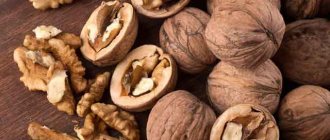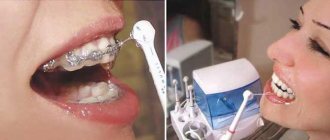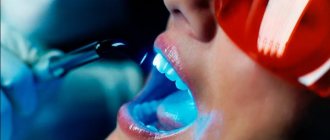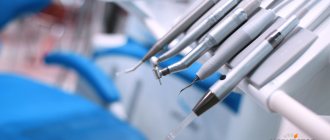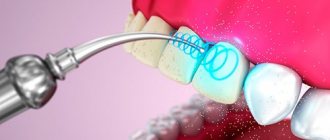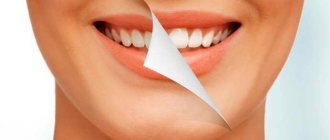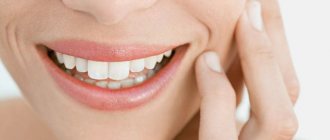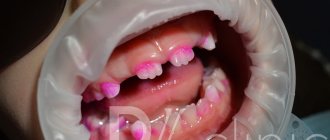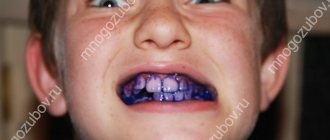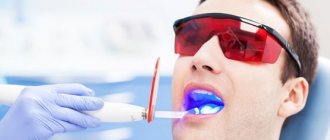Even with proper home hygiene, there are always inaccessible areas in the oral cavity. Deposits on the inner surface of the teeth, interdental and subgingival spaces are difficult to remove on your own. Plaque collects here, which over time turns into hard tartar. And this is fraught with the occurrence of various diseases.
Therefore, complete care requires the help of a specialist. Professional oral hygiene is necessary to prevent the development of caries, periodontitis and periodontal disease, as well as to get rid of dense plaque.
Why brush your teeth?
The oral cavity is one of the most infected parts of the body with various bacteria. Insufficient or improper care for it can lead to disastrous consequences.
Food residues on teeth under the influence of bacteria undergo rotting, decay and fermentation. In addition, soft plaque releases acid, which destroys the enamel, resulting in the formation of caries. This harms not only the teeth themselves, but is a source of bad breath, and can also provoke diseases of internal organs and reduce the body’s defenses (weaken the immune system).
If you do not brush your teeth, the following diseases may develop: chronic inflammation of the gums, gingivitis, caries, periodontitis, periostitis (flux), pulpitis, stomatitis, aphtha, gastritis, ulcers, and due to a weakened immune system - sore throat, type 2 diabetes mellitus, Alzheimer's disease, atherosclerosis, heart disease, stroke and even cancer.
What are the indications for professional teeth cleaning at the dentist?
It is recommended to consult a dentist for such a procedure in the following cases:
- the need to eliminate tartar in both supragingival and subgingival locations;
- removal of hard and soft plaque;
- for the prevention of diseases of hard dental tissues (caries and non-carious lesions);
- treatment and prevention of periodontal diseases (gingivitis, periodontitis, periodontal disease);
- eliminating bad breath;
- prevention of the development of periodontal bleeding;
- as the first stage of the teeth enamel whitening procedure.
The frequency of the procedure is recommended once every 6 months, but more often is possible. Modern methods of professional teeth cleaning are very gentle and do not have a negative effect on the oral cavity or to a minimal extent.
You can independently determine when you need to visit a clinic for professional cleaning by looking at the following negative signs in the oral cavity:
- bad breath, but gastrointestinal diseases have not been diagnosed;
- there is bleeding gums, itching and burning in the mouth;
- visual presence of tartar;
- the tooth may hurt;
- change in periodontal color (cyanosis or hyperemia);
- there is subsidence of the gums, they may bleed;
- there is a feeling of heaviness, pain in the periodontium when chewing food, especially sour or spicy;
- there is a violation of the periodontal attachment.
It should be noted that there are practically no contraindications for professional teeth cleaning. There are only general relative limitations, such as the acute stage of inflammatory processes in the body.
The basic methods of professional teeth cleaning are based on a modern correct approach to the problem and involve a complex effect during the process of professional teeth cleaning at the dentist. At the same time, manual and hardware cleaning methods are distinguished.
Hardware methods of teeth cleaning
Professional oral cleaning is performed by periodontists or hygienists. The procedure is preventive and does not require special preparation; in extreme cases, local anesthesia is performed. Of the hardware methods, the following techniques are the most popular.
Cleaning teeth at the dentist using the air flow method
During the cleaning process using the Air Flow method, hard dental deposits are exposed to abrasive material and a powerful stream of directed air. The abrasive commonly used is sodium bicarbonate. Cleaning takes place simultaneously with the supply of a thin stream of water. For an additional refreshing effect, different flavors (mint, lemon or menthol) are added to the water.
Cleaning occurs due to soda particles, which hit the enamel at high speed, removing both soft and hard plaque. At the same time, the supplied stream of water washes away the removed deposits and stones so that they do not interfere with further exposure. Water also helps reduce the heating of tooth enamel that occurs during this manipulation.
The Air Flow technique helps not only to eliminate plaque, stones and pigmentation, but also to thoroughly polish the enamel, at the same time ensuring its partial lightening. However, it should be remembered that air flow cannot whiten tooth enamel by several tones. After manipulation, hard tissues will only acquire their original color.
Reviews about Air Flow are in most cases positive, since the main advantages of the technique include:
- availability,
- safety,
- painlessness,
- high efficiency.
The entire effect takes no more than 30 minutes. Moreover, the air flow is selected individually for each patient. And the power directly depends on the volume of dental plaque that needs to be removed. In addition, the thickness of the enamel and the individual sensitivity of the teeth are taken into account.
Despite the positive aspects of professional teeth cleaning using the Air Flow method, there are quite significant contraindications to this method. First of all, these are diseases of the respiratory tract. These include:
- obstructive bronchitis,
- bronchial asthma,
- allergy to airflow components,
- acute diseases of periodontal and hard tissues,
- multiple caries,
- thin layer of enamel,
- non-carious lesions associated with increased sensitivity of the enamel and its excessive fragility.
The cost of the procedure in dental offices is usually not high and is affordable for everyone. In just 3-4 thousand rubles you can get a good preventive effect using the Air Flow method, as well as additional services to strengthen the hard tissues of teeth. The effect after the procedure lasts depending on the patient’s lifestyle and the absence or presence of somatic diseases. In any case, it is advisable to visit the dentist again no later than six months later.
How to brush your teeth correctly
Methods for proper brushing of teeth
1. Position the head of the toothbrush at a 45 degree angle to the gum line;
Read also Stomatitis and treatment at home
2. Brush your teeth in a circular motion from the gum to the top of the tooth (lower teeth from bottom to top, upper teeth from top to bottom);
3. Brush each tooth thoroughly;
4. Brush the chewing surfaces of the upper and lower molars with circular movements;
5. After thoroughly brushing your teeth, close your mouth and make circular movements with the toothbrush, grabbing the teeth and gums;
6. Next, brush your tongue, starting from the back and gradually moving towards the front.
7. After cleaning your mouth, rinse it thoroughly with water.
Below I post a picture in good resolution, which graphically displays the method of brushing teeth. If you click on it, it will open in a new window in excellent quality. You can also print it out and teach your kids from it.
Rules for brushing teeth
- brush your teeth 2 times a day - morning and evening (after the last meal); - brush your teeth for 2-3 minutes; - alternate pastes. Do not use the same toothpaste for a long time, use regular or whitening toothpaste in the morning, and regular or gel in the evening; — during the day, after eating, rinse your mouth with water or a special teeth rinse. You can also chew chewing gum, but no more than 15 minutes; — before brushing your teeth, be sure to rinse your toothbrush with water; - apply a small amount of paste to the brush, for children no more than 0.5 cm, for adults no more than 1 cm; — while brushing your teeth, do not press too hard on the brush; — after brushing your teeth, rinse the brush thoroughly with water and store it with the bristles facing up; - When brushing your teeth, lean forward over the sink so as not to swallow the toothpaste, because some of them contain fluoride, which is toxic to the body; - do not use toothpastes with a whitening effect to brush your teeth for a long time; - Use dental floss to remove food debris and plaque between teeth.
General teeth cleaning
For better dental health, it is necessary to carry out general teeth cleaning approximately once every 4 days in the evening:
— brush your teeth with regular toothpaste and rinse; - brush all teeth with floss; — smear the gel onto the brush and carefully (like a brush) apply it to the entire surface of the teeth from all sides; - We wait a little and rinse our mouth.
Oral care after brushing
Recommendations for oral care after the procedure are also almost the same:
- Do not eat for 2 hours after cleansing;
- for 2-3 days it is recommended to use a toothbrush with soft bristles so as not to injure the gums, the sensitivity of which increases after brushing;
- It is advisable to brush your teeth after each meal for 2-3 days. If this is not possible, rinse your mouth with clean water;
- You should stop smoking for a few days, otherwise the enamel will turn a deep yellow color;
- After cleaning the Air-flow, you need to exclude foods with rich dark colors from your diet for a week, such as beets, berries, mustard, blueberries, blackberries, chocolate - they can stain the enamel. You should also abstain from tea and coffee for a while.
The importance of maintaining oral hygiene is obvious. Professional preventative teeth cleaning helps maintain it at a high level.
Dental floss. How to use dental floss to clean your teeth?
No brush can clean the space between your teeth, but dental floss can easily do the job!
Read also Emergency help for toothache
To brush your teeth with floss, you must use only special dental floss, since ordinary sewing thread can damage the enamel or cut the gums.
How to use dental floss?
Tear off a piece of thread about 30 cm. Wrap the ends of the thread around the middle fingers of both hands.
Leave a piece of thread approximately 5 cm free, which you hold on both sides with your thumb and forefinger. Carefully move the piece between the teeth and with gentle movements, from the gum line, remove plaque from each side of the tooth. After cleaning the tooth, if the thread becomes dirty, use a new piece.
Care after professional cleaning
To consolidate the results of hygienic teeth cleaning, you need to carefully follow the dentist’s recommendations:
- do not consume drinks and fruits with coloring substances on the first day after the procedure;
- refrain from smoking;
- use toothpaste with a preventive, general strengthening effect (you need to check with your doctor how often it can be used).
Bleeding gums should make you doubt the professionalism of the doctor who performed the procedure. If everything is done correctly, then there should not be such consequences.
Do I need to clean my tongue?
Many people overlook cleaning their tongue, although bacteria accumulate on it just as easily as on teeth. If the tongue is not cleaned, then harmful microorganisms that adhere in the spaces between the taste buds of the tongue begin to multiply rapidly, and their waste products cause bad breath.
Adults need to brush their tongue in the same way as their teeth - 2 times a day. Children should be gradually accustomed to brushing their tongue, starting from the tip of the tongue, since the child may have a strong gag reflex, and pressure on the root of the tongue will be very unpleasant.
There are special tongue cleaners in the form of a scraper, and there is a tongue scraper on the back of the toothbrush head.
To clean your tongue, place the scraper on the back of the tongue as close to the root as possible and move it forward towards the exit, applying gentle pressure to the tongue.
Why do children's teeth darken?
The appearance of plaque on a child’s teeth is associated with poor oral hygiene. Due to the lack of systematic cleaning and the use of low-quality paste, microscopic remains of food and bacteria remain on the front and side teeth. Gradually, the milkweeds or indigenous ones turn from light yellow to dark, black.
Other causes of plaque on baby teeth:
- The diet contains foods and drinks with coloring pigments. Plaque in children does not appear slowly, but immediately after eating.
- Caries, especially common in dairymen. A small dark spot appears on the enamel on the inside or in front, gradually turning black and increasing in size.
- Injuries – damage to the vascular bundle. As a result, a hematoma forms in the pulp. Due to the ingress of pigment substances, the tooth becomes black at 3 years or more.
- Problems with the stomach (dysbiosis, bending of the child’s gallbladder) affect the change in shade. The stomach produces secretions that are artificially colored.
- Treatment with medications. For example, tetracycline antibiotics. They accumulate in the enamel tissues of a one-year-old child or older children. After antibiotics, only a dentist can treat.
Another reason is fluorosis. This is a disease that develops due to the use of fluoride in excessive quantities. Black dots begin to appear on the teeth in large numbers. Gradually they merge. A coating forms on the tongue. The clinical picture is complemented by purulent changes in the skeletal and muscular system.
How to choose a toothbrush?
The brush must be changed regularly.
Basically, a medium-hard brush can be used for 3 months, and a soft one for 1-2 months.
It is not recommended to share a brush with someone else, so as not to suffer a possible infection.
When choosing a toothbrush, give preference to brushes made of artificial fiber, since brushes made of natural bristles are unhygienic - microbes multiply faster in them, which can contribute to the development of various oral diseases.
Toothbrushes come in different hardnesses:
- very soft (ultrasoft, extrasoft). Recommended for children under 5 years of age and people with hypersensitive teeth; - soft. Recommended for children from 5 to 12 years old, as well as for bleeding, swelling and sore gums; — average (medium). Recommended for children over 12 years old and adults; - hard and very hard. Hard and very hard toothbrushes should not be used without a doctor’s recommendation.
They can only be prescribed by a doctor and then for a short period of time.
The most common mistakes when brushing your teeth
- Skipping an evening cleanse.
Some people find it sufficient to brush their teeth once a day - in the morning when they go to work. It is not right. At night, little saliva is produced, so food debris is washed off the surface of the teeth, and bacteria actively multiply in them. They produce acids that destroy teeth and gases that cause unpleasant odors.
- Rare brush replacement.
Over time, the bristles wear out and cleaning becomes less effective. In addition, over time, even synthetic bristles accumulate germs, so it is important to change the brush or head every three months.
- Too much pressure.
Brushing your teeth with a regular brush requires moderate pressure, otherwise you can damage the enamel and gums. The electric brush requires virtually no pressure; it is only lightly pressed against the surface of the teeth.
Avoid these mistakes, then you can maintain oral health longer.
How to choose toothpaste?
Toothpastes come in the following types:
- hygienic toothpastes. Designed to clean teeth and freshen the oral cavity;
Read also: What modern methods of caries treatment exist?
- therapeutic and prophylactic. Designed for the prevention of caries (containing fluoride and calcium compounds), for the prevention and complex treatment of periodontal diseases (containing chlorhexidine, triclosan, lysozyme, trypsin, plant extracts, propolis, vitamins), to reduce tooth sensitivity (with hydroxyapatite and potassium compounds);
- bleaching agents containing hydrogen peroxide or urea. This paste oxidizes pigments, visually brightening teeth, or contains coarse abrasives that can remove dense pigmented plaque. Whitening toothpastes should not be used to brush your teeth every day, and should only be purchased on the recommendation of your doctor.
If you do not have problems with your teeth and gums, then you can choose a hygienic paste to suit your taste. If you need a preventive or therapeutic paste, then follow the doctor’s recommendation and your own needs.
Only children's toothpaste is suitable for children.
Is it possible to brush your teeth with soda or salt?
To clean their teeth, some people use folk remedies such as baking soda instead of toothpaste. Due to its abrasive properties, it is believed that this product can whiten teeth well. And this is true, but the whitening effect will be achieved due to the fact that the soda will literally tear off the top layer of enamel, which is the protective layer of the tooth.
Also, there is an opinion that it is useful to brush your teeth with salt, as it has many useful elements. Yes, salt helps remove plaque, and in some cases, tartar, but under no circumstances should it be used daily, as the enamel will be damaged; also, salt for brushing teeth should be very fine.
Modern dentistry categorically does not recommend using salt or soda to brush your teeth.
The range of services for professional oral hygiene includes:
- dental mechanical cleaning,
- ultrasonic cleaning,
- cleaning using Air Flow,
- teeth polishing,
- fluoridation of teeth.
Mechanical cleaning is done using cutting instruments - curettes, or rapidly rotating special brushes and paste. It is effective against mineral deposits on teeth. Currently rarely used, but can be used when other methods are contraindicated.
Ultrasonic cleaning is most often used. It emits vibrations that are transmitted to the surface of the teeth through a stream of water. As a result, tartar is crushed into small pieces and is easily separated from the surface. The Air Flow method allows you to quickly get rid of pigmented plaque. The teeth are treated with an abrasive compound, then cleaned with a sandblasting device. No chemicals are used, making the technology absolutely safe.
After these procedures, it is recommended to polish the enamel with special pastes and brushes. The surface of the tooth becomes smooth, less plaque forms on it, which means the risk of developing caries is reduced.
Fluoride preparations are applied to the polished enamel, so they are better absorbed and protect the tooth surface from microbes.
Interesting statistics
Women aged 13 to 50 answered the following questions:
— believe that you need to brush your teeth 2 times a day — 73%; — know what tooth gel is — 38%; — use tooth gel — 13%; — know what mouthwash is — 25%; - use a mouth rinse - 8%; - know what dental floss is - 13%; — use dental floss — 4%; - have false teeth or crowns before the age of 30 - 28%; — more than 1 tooth removed before age 30 — 37%; — more than half of the teeth are filled or require treatment — 68%; — visit the dentist once every six months — 9%; - visit the dentist only when a tooth hurts - 91%.
Experts recommend visiting a dentist for professional teeth cleaning 1-2 times a year.
What is professional teeth cleaning at the dentist?
Oral care can be done both at home and in the dentist's office.
Daily home care does not completely eliminate the risk of oral diseases. Therefore, during regular dental examinations, you should periodically have your teeth professionally cleaned. Modern cleaning methods allow you to remove all plaque from the enamel and remove existing tartar in a short time. At the same time, the teeth are restored to their natural whiteness and various oral diseases are prevented.
The professional teeth cleaning procedure is painless. Its main advantage, in addition to the removal of visible dental plaque, is the reduction of pathogenic microflora in the oral cavity and the increase of local immunity.
What is plaque and tartar?
Dental plaque is essentially a mass of food debris, saliva, pathogenic microorganisms and their waste products. Daily brushing removes plaque only on open and easily accessible areas of the teeth. In places that are difficult to clean independently, plaque accumulates in large quantities. This is, first of all, the cervical area of the teeth, fissures on the chewing surface and the gingival groove.
After a few days, the plaque turns into a hard plaque. The concentration of harmful microorganisms in it is 50% higher than in unhardened plaque. Such a plaque cannot be washed off with saliva or water. The plaque gradually grows and a very dense deposit is formed from it - tartar. This education contributes to the development of periodontal diseases (periodontitis and periodontal disease) and caries.
